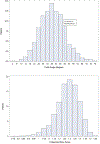Trabecular bone score and its association with Cobb angle kyphosis in older men: a cross-sectional study for the Osteoporotic Fractures in Men (MrOS) Study
- PMID: 35031808
- PMCID: PMC9010364
- DOI: 10.1007/s00198-021-06267-w
Trabecular bone score and its association with Cobb angle kyphosis in older men: a cross-sectional study for the Osteoporotic Fractures in Men (MrOS) Study
Abstract
Hyperkyphosis (HK), or accentuated forward spinal curvature, commonly affects older people, although its causes are not completely understood. We tested whether a measure of bone quality, trabecular bone score (TBS), is associated with HK in 1997 older men, and determined that men with degraded TBS were more likely to have HK.
Introduction: While vertebral fractures and low bone mineral density (BMD) contribute to kyphosis progression, it is unknown whether the trabecular bone score (TBS) may provide additional information on bone quality that could influence the degree of kyphosis. We hypothesized that degraded TBS would be associated with hyperkyphosis (HK) defined as a Cobb angle > 50°.
Methods: Using data from 1997 participants of the Osteoporotic Fractures in Men (MrOS) Study who had baseline TBS and Cobb angle kyphosis measured, we investigated whether men with degraded TBS were more likely to be hyperkyphotic, even after adjustment for BMD and prevalent vertebral fractures.
Results: Men were an average age of 74 ± 6 (mean ± SD) years with a mean kyphosis angle of 38.6 ± 11.5°, 295 (15%) were classified as hyperkyphotic, and 416 (21%) had degraded TBS. Compared with men with TBS > 1.2, men with degraded TBS were more likely to have HK (OR: 1.47, 95% CI: 1.06-2.06, p = 0.02) after adjusting for age, clinic, race, BMI, hip BMD, and prevalent vertebral fracture. If spine instead of hip BMD was included in the model, the odds ratio decreased to 1.35 (95% CI: 0.97-1.89, p = 0.08).
Conclusions: Older men with degraded TBS are more likely to have HK not explained by underlying vertebral fractures.
Keywords: Bone mineral density; Hyperkyphosis; Kyphosis; Trabecular bone score; Vertebral fractures.
© 2021. This is a U.S. government work and not under copyright protection in the U.S.; foreign copyright protection may apply.
Conflict of interest statement
Reema Patel, Jian Shen, Jeanne Nichols, John Schousboe, Gina Woods, Wendy Katzman and Deborah Kado declare that they have no conflicts of interest.
Figures
Similar articles
-
Factors Associated With Kyphosis and Kyphosis Progression in Older Men: The MrOS Study.J Bone Miner Res. 2020 Nov;35(11):2193-2198. doi: 10.1002/jbmr.4123. Epub 2020 Aug 12. J Bone Miner Res. 2020. PMID: 32615004 Free PMC article.
-
Determinants of trabecular bone score and prevalent vertebral fractures in women with fragility fractures: a cross-sectional sub-study of NoFRACT.Osteoporos Int. 2020 Mar;31(3):505-514. doi: 10.1007/s00198-019-05215-z. Epub 2019 Nov 21. Osteoporos Int. 2020. PMID: 31754755 Free PMC article.
-
Association of Trabecular Bone Score (TBS) With Incident Clinical and Radiographic Vertebral Fractures Adjusted for Lumbar Spine BMD in Older Men: A Prospective Cohort Study.J Bone Miner Res. 2017 Jul;32(7):1554-1558. doi: 10.1002/jbmr.3130. Epub 2017 Apr 7. J Bone Miner Res. 2017. PMID: 28300346 Free PMC article.
-
Use of Trabecular Bone Score (TBS) as a Complementary Approach to Dual-energy X-ray Absorptiometry (DXA) for Fracture Risk Assessment in Clinical Practice.J Clin Densitom. 2017 Jul-Sep;20(3):334-345. doi: 10.1016/j.jocd.2017.06.019. Epub 2017 Jul 19. J Clin Densitom. 2017. PMID: 28734710 Review.
-
Utility of Trabecular Bone Score in the Management of Patients with Osteoporosis.Endocrinol Metab Clin North Am. 2024 Dec;53(4):547-557. doi: 10.1016/j.ecl.2024.07.001. Epub 2024 Aug 30. Endocrinol Metab Clin North Am. 2024. PMID: 39448136 Review.
Cited by
-
Short term effect of spinal mobilization with movement (MWM) on pulmonary functions in nonsmokers with thoracic hyperkyphosis: a randomized single-blinded controlled trial.J Man Manip Ther. 2023 Apr;31(2):64-71. doi: 10.1080/10669817.2022.2075203. Epub 2022 May 26. J Man Manip Ther. 2023. PMID: 35616265 Free PMC article. Clinical Trial.
-
Characterizing aging-related genetic and physiological determinants of spinal curvature.Commun Med (Lond). 2025 Jul 12;5(1):291. doi: 10.1038/s43856-025-01003-5. Commun Med (Lond). 2025. PMID: 40652108 Free PMC article.
-
Enhancing Osteoporosis Management: A Thorough Examination of Surgical Techniques and Their Effects on Patient Outcomes.Cureus. 2024 May 5;16(5):e59681. doi: 10.7759/cureus.59681. eCollection 2024 May. Cureus. 2024. PMID: 38836146 Free PMC article.
References
-
- Kado DM, Prenovost K, Crandall C. Narrative review: hyperkyphosis in older persons. Ann Intern Med. 2007;147(5):330–338. - PubMed
-
- McDaniels-Davidson C, Davis A, Wing D, et al. Kyphosis and incident falls among community-dwelling older adults. Osteoporosis Int. 2018;29(1):163–169. - PubMed
-
- Schneider DL, von Mühlen D, Barrett-Connor E, et al. Kyphosis does not equal vertebral fractures: The Rancho Bernardo study. J Rheumatol. 2004;31(4):747–752. - PubMed
MeSH terms
Grants and funding
- R01 AG024246/AG/NIA NIH HHS/United States
- AG027810/AG/NIA NIH HHS/United States
- AR066160/AR/NIAMS NIH HHS/United States
- UL1 TR000128/TR/NCATS NIH HHS/United States
- AG024246/AG/NIA NIH HHS/United States
- U01 AG042124/AG/NIA NIH HHS/United States
- U01 AG042145/AG/NIA NIH HHS/United States
- AG042124/AG/NIA NIH HHS/United States
- AG042168/AG/NIA NIH HHS/United States
- U01 AG042140/AG/NIA NIH HHS/United States
- AG042145/AG/NIA NIH HHS/United States
- AG042140/AG/NIA NIH HHS/United States
- TR000128/NH/NIH HHS/United States
- U01 AG042143/AG/NIA NIH HHS/United States
- U01 AR066160/AR/NIAMS NIH HHS/United States
- U01 AG042168/AG/NIA NIH HHS/United States
- AG042139/AG/NIA NIH HHS/United States
- U01 AG027810/AG/NIA NIH HHS/United States
- AG042143/AG/NIA NIH HHS/United States
- U01 AG042139/AG/NIA NIH HHS/United States
- R01 AR060828/AR/NIAMS NIH HHS/United States


